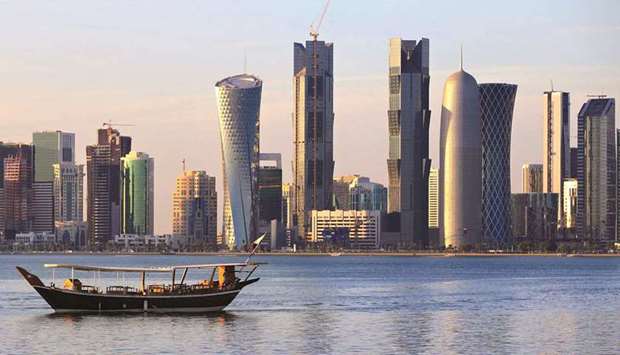Qatar's economy will grow 3% this year, 4.1% in 2022 and at the GCC’s best rate of 4.5% in 2023; World Bank’s revised forecast has shown.
The forecast indicates that Qatar's economy has absorbed the pandemic-induced shocks and is back again on the growth trajectory.
In 2020, the World Bank had estimated that Qatar’s economy would have contracted -3.7%, obviously due to the impact of Covid-19 pandemic.
In 2018, Qatar’s economy grew 1.2%, and by only 0.8% in 2019.
Next year, only Oman would grow faster (World Bank forecast: 6.5%) than Qatar.
And in 2023, Qatar will outperform all the other Gulf Cooperation Council countries, according to the World Bank forecast.
The World Bank's 2021 growth forecast for other GCC countries is Kuwait (2.4%), Oman (2.5%), Saudi Arabia (2.4%) and UAE (1.2%).
In 2022, Bahrain has been forecast to grow at 3.2%, Kuwait (3.6%), Saudi Arabia (3.3%) and UAE (2.5%).
In 2023, World Bank has forecast Bahrain’s growth at 3.2%, Kuwait (2.8%), Oman (4.2%), Saudi Arabia (3.2%) and UAE (2.5%).
In its regional outlook, the World Bank noted output in the region is expected to grow by 2.4% in 2021, stronger than initially forecast, but below the previous decade average, ending 2019. The region should benefit from the recent rebound in oil prices, stronger external demand, and less economic disruptions from Covid-19 outbreaks.
“As vaccinations rise, mobility restrictions ease, oil production cuts taper, and damage to balance sheets reverse, growth should accelerate further to 3.5% in 2022. The outlook is, however, uncertain and depends on the course of the pandemic and vaccination availability and take-up,” World Bank said.
It said the pandemic is expected to continue to be a drag on economic growth among oil importing economies. In Egypt, growth is forecast to slow to 2.3% in FY2020/21, reflecting damage to tourism, manufacturing, and oil and gas extractives from the pandemic, before strengthening again in FY 2021/22.
In Morocco, output is expected to rebound to 4.6% in 2021 as drought conditions fade, policy remains accommodative, and domestic mobility restrictions ease.
Economies beset by fragility, conflict, and violence face mixed prospects. In Libya, the creation of an interim unity government and the lifting of the oil blockade is expected to restore economic activity to close to 2019 levels. In Iraq, output is forecast to expand as oil production rebounds but won’t be enough to reverse a substantial rise in poverty rates. In Lebanon, further contraction is expected in 2021.
The World Bank noted the region’s “risks are tilted to the downside” and are related to the possibility of resurgence of Covid-19 cases, delays in vaccination rollout, weaker oil prices in the context of limited economic diversification, higher agricultural prices and food insecurity, and conflict and social unrest.
“Limited economic diversification continues to present risks as oil demand is expected to remain below pre-pandemic levels through 2023. Social unrest and conflict are recurring downside risks to region. The intersection of higher food prices, fragility and conflict, political risk and resurgent outbreaks of Covid-19 pose significant economic and social risks to the region,” World Bank said.
The forecast indicates that Qatar's economy has absorbed the pandemic-induced shocks and is back again on the growth trajectory.
In 2020, the World Bank had estimated that Qatar’s economy would have contracted -3.7%, obviously due to the impact of Covid-19 pandemic.
In 2018, Qatar’s economy grew 1.2%, and by only 0.8% in 2019.
Next year, only Oman would grow faster (World Bank forecast: 6.5%) than Qatar.
And in 2023, Qatar will outperform all the other Gulf Cooperation Council countries, according to the World Bank forecast.
The World Bank's 2021 growth forecast for other GCC countries is Kuwait (2.4%), Oman (2.5%), Saudi Arabia (2.4%) and UAE (1.2%).
In 2022, Bahrain has been forecast to grow at 3.2%, Kuwait (3.6%), Saudi Arabia (3.3%) and UAE (2.5%).
In 2023, World Bank has forecast Bahrain’s growth at 3.2%, Kuwait (2.8%), Oman (4.2%), Saudi Arabia (3.2%) and UAE (2.5%).
In its regional outlook, the World Bank noted output in the region is expected to grow by 2.4% in 2021, stronger than initially forecast, but below the previous decade average, ending 2019. The region should benefit from the recent rebound in oil prices, stronger external demand, and less economic disruptions from Covid-19 outbreaks.
“As vaccinations rise, mobility restrictions ease, oil production cuts taper, and damage to balance sheets reverse, growth should accelerate further to 3.5% in 2022. The outlook is, however, uncertain and depends on the course of the pandemic and vaccination availability and take-up,” World Bank said.
It said the pandemic is expected to continue to be a drag on economic growth among oil importing economies. In Egypt, growth is forecast to slow to 2.3% in FY2020/21, reflecting damage to tourism, manufacturing, and oil and gas extractives from the pandemic, before strengthening again in FY 2021/22.
In Morocco, output is expected to rebound to 4.6% in 2021 as drought conditions fade, policy remains accommodative, and domestic mobility restrictions ease.
Economies beset by fragility, conflict, and violence face mixed prospects. In Libya, the creation of an interim unity government and the lifting of the oil blockade is expected to restore economic activity to close to 2019 levels. In Iraq, output is forecast to expand as oil production rebounds but won’t be enough to reverse a substantial rise in poverty rates. In Lebanon, further contraction is expected in 2021.
The World Bank noted the region’s “risks are tilted to the downside” and are related to the possibility of resurgence of Covid-19 cases, delays in vaccination rollout, weaker oil prices in the context of limited economic diversification, higher agricultural prices and food insecurity, and conflict and social unrest.
“Limited economic diversification continues to present risks as oil demand is expected to remain below pre-pandemic levels through 2023. Social unrest and conflict are recurring downside risks to region. The intersection of higher food prices, fragility and conflict, political risk and resurgent outbreaks of Covid-19 pose significant economic and social risks to the region,” World Bank said.



